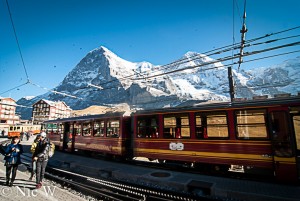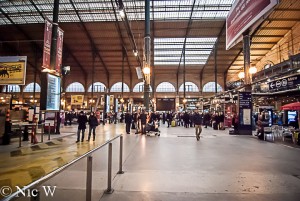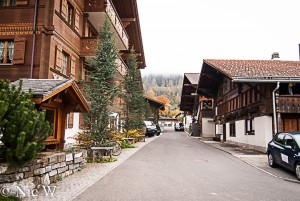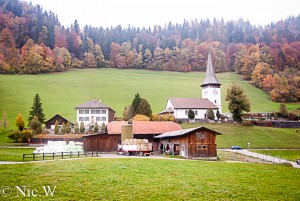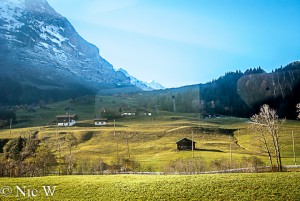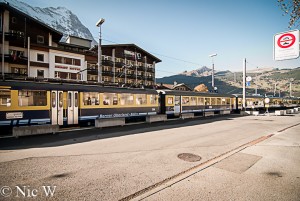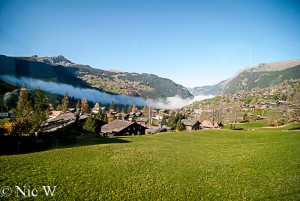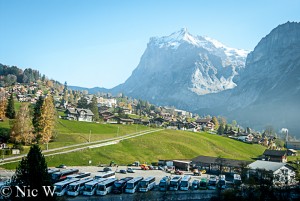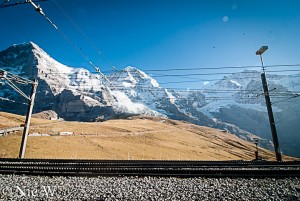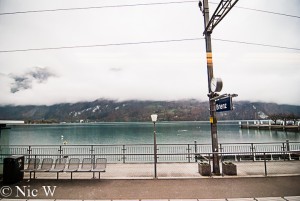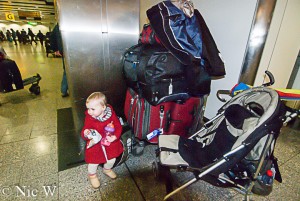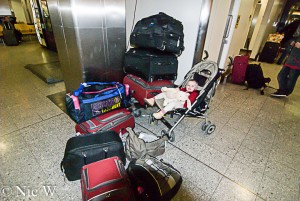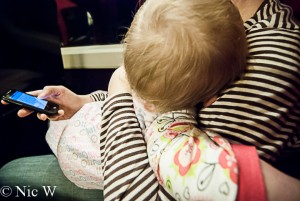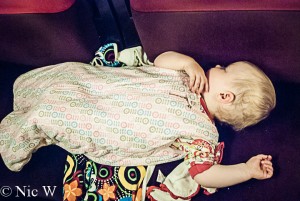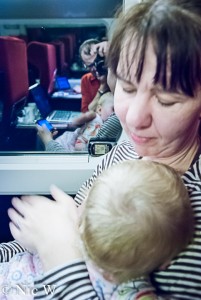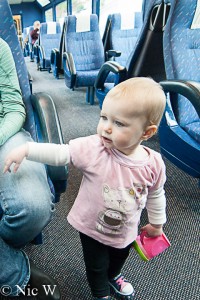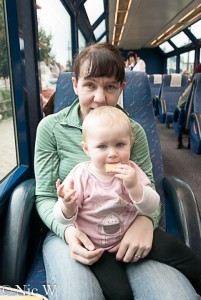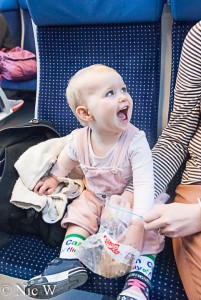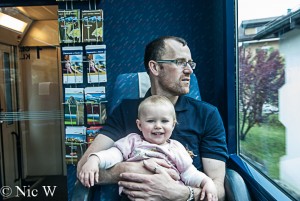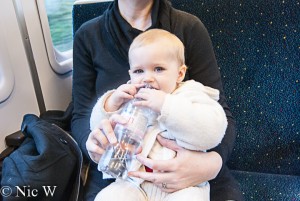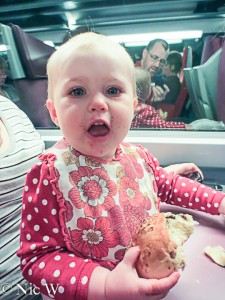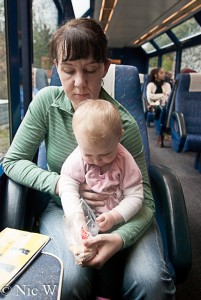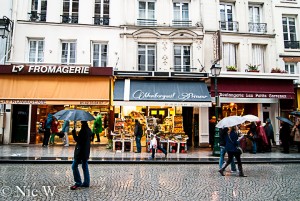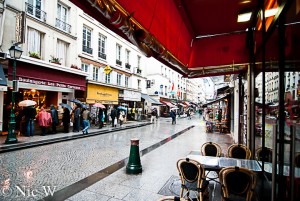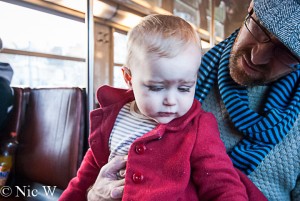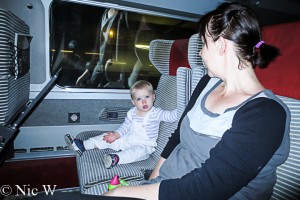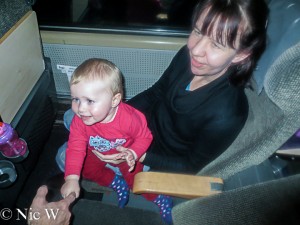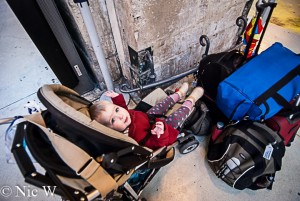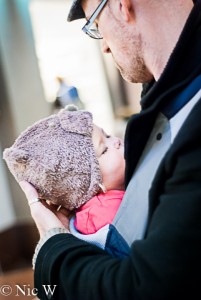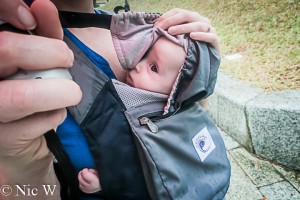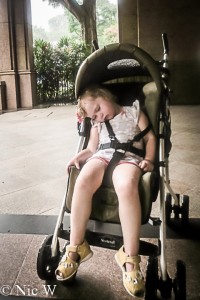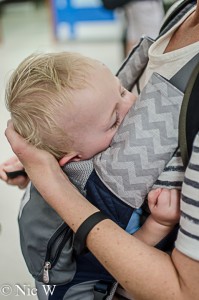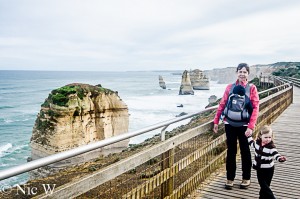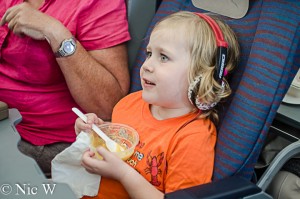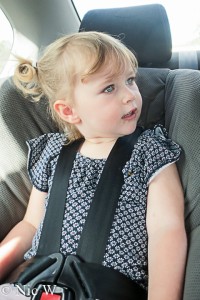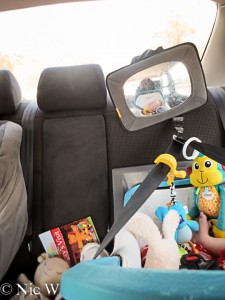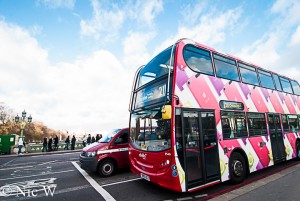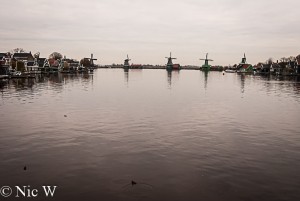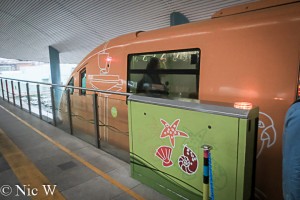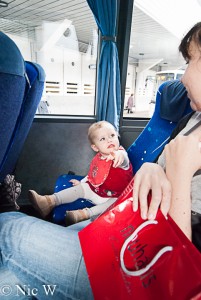In my first post about travelling with kids (check it out here!) I covered different ways we plan our travel, flying with kids and how to cope with the inevitable jet lag. In this post I’ll talk more about how to deal with your small people on other forms of transport – trains, car travel, taxis and public transport.
Train travel with babies and kids
Anyone who followed our Europe 2012 trip, knows we did a lot of train trips, both within France and to and around Belgium, Luxembourg, Switzerland, the Netherlands, London and Sweden. Our upcoming trip has even more train travel planned, at least 18 days with medium to long train trips between cities (more days with short trips within cities). Can you tell we are fans of train travel in Europe?
Why do we like train travel so much? It’s relatively cheap, it’s fast, efficient, clean and easy. Every country has their own train company (or companies) so the standard, costs and efficiency do differ between service provider, but overall we haven’t had any bad experiences. Some trips were definitely more comfortable and enjoyable than others, but nothing so horrendous we wouldn’t continue to use trains when we can.
Compared to flying, train travel is generally much cheaper. If you buy the discounted tickets (usually on sale around 90 days from departure) you can get some very cheap fares. There are also a multitude of travel pass options, both across countries and within individual countries. Costing which are the best fares and passes seems to be an art-form, but Anto is the train master. One day I’ll make him write a post on the best way of going about the costings. If you are travelling with young kids the cost advantage over flying can be huge. Once kids hit 2 you have to pay for a seat for them on airlines, the cost is normally close to, if not, full adult price. The age limit for kids for free kid travel varies between train companies, but under 6’s are usually free and some offer free seats up to 15 years of age. The kids prices are often less than full adult price, so when travelling with older kids there are still price advantages to train travel.
In many cities the airports are out of the city some distance. The train stations are usually fairly centrally located, this is a huge advantage when travelling between cities by train. You can often get off your train and get a short metro ride or walk to your accommodation, rather than having to get a taxi or find a train station to get from the airport to your accommodation. When booking accommodation, if we know we are travelling by train, we try to look for accommodation near to either the central station or a metro station to save time (and energy) when moving bags around.
When flying internationally, you have to be at the airport at least 90 minutes before departure. If the airport is out of the city this can mean you need to leave your accommodation to get to the airport 2-3 hours before your flight time. When you are catching the train between countries, you can be at the train station 5 minutes before departure! It is advisable to be there a little earlier in case of delays and to give yourself enough time to find the correct platform, which can take time in the big stations. However, it is easier to rock up the train station and roll your bags onto the train rather than waiting around for long periods in the airport. Once you arrive, it’s a quick process to grab your bags and head off and straight out of the train station (or onto the connecting train or metro).
The time efficiency in not having to get to and from airports and not needing the long wait time before boarding means that it’s often not worth flying if the train trip is under around 4 hours. Even though the comparable flight time will be shorter, all the extra transit time (and generally higher cost) of flying is not worth it for us, and we choose to use trains. As much as I love the train trips around Europe there are times we have chosen to fly (Paris to Sweden and Copenhagen to Berlin, for example) as the flight times are significantly shorter than the train travel times. For our upcoming trip there were a few legs where we considered overnight trains and longer train legs, but ultimately decided they were a little annoying with young kids, due to either the departure and arrival times or the number of stops. If we weren’t travelling with kids, they might be more appealing.
When you are planning and booking your train legs it’s advisable to know how many stops the train has. The high speed trains without stops are extremely efficient ways of getting between countries and cities and reach speeds of 300km/h quickly. Even a relatively long trip like Zurich to Paris is only 4 hours on the non-stop high speed train. One of our best memories of our last European trip was standing at the amazing Zurich central station as the snow was falling all around us (it was the first snow day of the season ) and boarding our evening train back to Paris. After a long day of walking around in the cold and snow we settled back and as the train set-off and quickly accelerated up to 300km/h with the snow hurtling past the windows. The sun was setting and all the chocolate box houses were getting their first covering of thick snow. It was an amazing sight. A few hours later we were back in Paris, walking past the smell of freshly cooking crepes from the crepe stands between Gare du Nord station and our apartment. Everyone needs hot crepes at 10pm, right?
There are times we’ve booked the ‘scenic’ train trips rather than the express. We did this quite a bit through Switzerland on our last trip and have again selected some longer but more scenic routes on our upcoming trip. There are times we are happy to spend a couple more hours on the train and have more interesting views out the window and be able to stop in other towns or villages for a wander. It’s a good way to see lots of smaller town or villages in one travel day. We saw lots of Switzerland and Belgium by this method – a couple of hours wandering a village, or half a day in a city, and 20-40 minutes on the train and off again for the next one. It’s great for when it’s cold and you don’t want to be walking around for too long! We would generally store our bags in the train station so we only had to wander with a day pack (and Astrid).
Trains also generally don’t have luggage restrictions. However, if you don’t have a reserved seat you can end up standing with a pile of luggage in the corridor or vestibule, which isn’t fun! You also have to get your luggage on and off the train, so less bags are preferable. There usually isn’t a weight or size restriction though, unlike airlines. As I normally had to carry Astrid, Anto was in charge of bag movement. We did manage to move almost 200kg of luggage through London on the tube, so if you can do that, anything is possible – I wouldn’t recommend it though. Most of the time we only had a few suitcases and they were never a problem. Often someone would lend us a hand. You do need to know your stop and be ready with your bags.
The time the train is stopped is fairly limited so I would get myself and Astrid on and off (usually carrying our hand-luggage as well) and Anto would throw the other bags on and off the train as needed. We had a few stations that were quite busy, and it was a bit of a rush, however there are plenty of people doing the same thing, so no one bats an eyelid at 4 or 5 big suitcases being thrown off trains in a hurry. Suitcases with wheels are definitely better for moving between train stations and getting onto the platforms, but we also have a big wheelie backpack which meant Anto could carry more in one go. As we used trains so much on our last trip, the couple of times we flew we had to consciously remember to check our bags for scissors and knives and other ‘banned’ items as we had got lax about being able to carry whatever we liked in our luggage. We generally tried to keep our luggage within eyesight, but sometimes it had to be stored a little further away. We always kept travel documents, wallets and the camera gear in our hand luggage, near us, and didn’t have any incidents with our luggage being tampered with. There were obviously issues in a few places though, as there would sometimes be announcements to be wary of theft – this happened every time we went past Antwerp in Belgium and a few areas in Paris. We noticed extra guards and security would hop on the trains in these areas.
One huge advantage train travel offers over car and plane travel is space! At least on the high speed international trains the seats are bigger than economy airline seats (similar in size to premium economy or sometimes business class) and there is usually more leg room. It is also possible to get up and walk around when kids get restless. You can even go for walks up and down the train to visit the food cars (and the toilets), and this can fill in time. In most of the long distance trains the seats are arranged in groups of 4 with a table in between which is good for putting laptops or colouring in books on. They also generally have power outlets for charging phones and computers and many had free wifi. We kept Astrid entertained for hours with episodes of ‘Playschool’ playing on the laptop and I could edit photos and catch up on blog posts while we travelled. It was generally much more comfortable than flying. We had a few train trips where the trains were crowded and the seats were smaller. These tended to be trips under an hour or two without reserved seats, so having Astrid on my lap and little leg room wasn’t a massive issue, but it wouldn’t have been ideal on the really long trips. We often planned our longer trips for evening so Astrid would fall asleep long after the start of the trip, and sleep until we arrived at our destination. She spent many an evening sleeping across some train seats in her sleeping bag as we whizzed through some countries at 300km/h!
First class vs economy
On our last trip we did most of our longer trips on our Eurail pass which gave us first class seats. Unlike flying the difference between first class on most of the trains isn’t enormous. First class seats are roomier and nicer, with a little more leg room and generally in a not too large cabin. Some first class tickets included a light meal – usually a croissant and juice, although we got a small hot meal a couple of times. Whether first class is worth it, depends a little on the price you can pick the tickets up for. As we were using Eurail pass days it was nice to have the extra space and comfort, especially on the longer trips and those with nice scenery. We are currently costing train legs for our upcoming trip and deciding which ones (if any) are worth upgrading to first class on. Most of the time, the discounted economy tickets are the best value and more than adequate for space and comfort.
Food on trains
Some times we were provided with a light meal (often this wasn’t clear on our ticket purchase so we didn’t count on it). Usually though we took our own food and drinks with us. Some of the trains had a food car on-board but we didn’t often use them as they were usually pricey, and not that interesting. There were a couple of times we grabbed coffees and hot chocolates on long trips or the odd toasted croissant, when we were a bit hungry.
For our early morning international trips we would wander past one of the many superb boulangeries and/or patisseries on the way to the train station and pick up some treats. Astrid often scored a chocolate brioche or almond croissant to munch on (so deprived that child!). We generally picked up something for ourselves to munch on and made sure we had plenty of water too. A few times, when travelling back to Paris, late at night, we were stuck with train station vending machines or corner store offerings. Astrid never complained about her cobbled together dinners of packets of chips and a block of cheese!
Like travelling on planes, it definitely pays to make sure you have lots of snacks handy – and wipes, always have the baby wipes!
Tips for travelling on trains with kids
If you are travelling with very young kids, try and get a seat in a carriage with a baby change facility (they are usually clearly marked, but not in every carriage). If you have reserved seats, you will often end up in one (or near one), but if you can choose your seats, try and pick one close to the change facilities so you are not walking through 10 carriages on a moving train with a wet or smelly baby.
It is usually a good idea to consider reserving seats, particularly if you are on a long trip or have lots of luggage. Reservation fees usually apply, and they can be pricey. On some of the French trains the reservation fee was a significant portion again of ticket cost. In other countries, it was a marginal cost and definitely worthwhile. Despite the additional cost, having guaranteed seats, together is useful. Without reserved seats you can end up spread throughout the train and/or without a seat at all. This wasn’t really an issue on shorter trips, and there were times we ended up all standing. Usually, as I had a young Astrid with me, I would be offered a seat and Anto would stay with the luggage, but we did end up split up in different carriages at times. Some trains don’t offer reservations, but when they are available it’s worth considering. It also means you are more likely to have somewhere to store your luggage near your seats, and don’t have to seat-hop for several hours. If it’s a scenic train route, a guaranteed seat will also mean you will see more.
It’s a good idea to turn up to the train station with plenty of time to find the correct platform and have your ticket inspected. Some of the train stations are large and it takes time to walk from one end to another, especially with small kids and lots of luggage! Often tickets would be inspected before boarding, but in some countries this would happen while on the train. Passports generally weren’t checked within the EU, but this might be different on our next trip with the current refugee migrations. You can in theory turn up just before you train is due to leave, but a bit of leeway is advisable. We found most of the trains very efficient. Delays were usually well communicated but most ran fairly on time, messages about ‘perturbed trains’ in France wasn’t uncommon! The Swiss trains were extremely punctual as per their reputation. They left on time to the second – you could watch the large display clocks that give a 5 second warning to departure time, and then they would go, you had to know the protocol.
Unlike planes, you can access your luggage during the trip. In theory anyway. In practice it could be buried under several other peoples large suitcases. It’s a good idea to pack anything you need for the trip in a smaller carry on bag you can keep under your seat. Snacks, spare clothes, nappies, wipes and some small toys, books or laptops, tablets to keep the kids entertained.
We always try to time the longer train trips for first thing in the morning, or late in the evening so that not too much of a day is wasted in a new city. For the late trips we would feed Astrid her dinner, put her in her pyjamas and giver her her cup of milk and get her off to sleep for the duration of the journey. We’d then pop her in the carrier once we arrived and she’d nap on and off on the metro rides and walks back to our apartment or the accommodation. If it was a shorter trip, we’d sometimes time it for nap/rest time in the middle of the day.
Know your stop and have all your items packed up prior to arriving at the station. If the train is terminating you don’t have to rush, but most stops on a continuing line are quite short. You want to be packed up, and ready to get your luggage and disembark as quickly as possible. We’d pop Astrid in the carrier and I’d load up with our hand luggage, so Anto was free to grab all our suitcases.
As some of the train stations are big and spread out, baby carriers are ideal for keeping small kids safe and moving around efficiently. We did sometimes take the stroller with us, but it was much harder to maneuver a stroller and push/pull suitcases. With a carrier I still had 2 hands free to pull luggage. Big train stations often have lifts or escalators, so without too much luggage strollers and prams are doable. Just look for the disabled access signs.
Car travel with babies and kids
We are far less experienced with long car trips with kids than many of our friends and family. We have done several long trips within Australia – some return trips to Sydney (600km round trip), a Melbourne trip (1200km round trip) and our Great Ocean Road trip (over 2000km). We also did a bit of driving around rural France, when we visited the Loire valley. In general we prefer to fly or train for most of our holidays, but there are times when the convenience and cost-effectiveness of the car wins out!
The one big advantage of car travel over other forms of transport, is that you can stop when you want to or need to! When you are stuck on a plane with 8 hours to go with a screaming baby, the ability to stop would be nice. However, at least in Australia, there isn’t always somewhere convenient to stop, so it pays to be prepared with snacks and know how far to the next convenient stopping place.
You also have greater flexibility with car travel, you can go where you want, when you want and stop as often as you want. The additional luggage space and not having to move bags around constantly is also nice.
Like flying and long train trips we always pack some entertainment for the kids. Rattles or toys for when they are little and books, colouring or the DVD player for when they are a little older. We only use the DVD players on longer trips (not around town) but our theory is that they would be watching TV on a plane so the car is fair game……… and silence is golden! Like I suggested when flying, buy kid-sized headphones, and they can watch their TV in peace and you don’t have to listen to it! Make sure you have a variety of different shows and movies you can access. Listening to the same 3 episodes of Peppa Pig for 20 hours is a little repetitive.
Tips for long car trips with babies and toddlers
Know your stops! Often when travelling in Australia there is nowhere useful for toilet, petrol or food stops for hours at a time. It’s useful to know where all the towns and rest stops, and the distance/time between each so that when the kids are cranky or need a toilet stop you know how long you have to go.
Make sure you have plenty of snacks and drinks to keep you and the kids going between stops. Like all long distance travel, what they eat is of little importance to me, if they are happy and quiet. Less messy foods are ideal, but I don’t really care about nutritional value for long days in the car.
Make sure you have plenty of entertainment on hand. Unlike flying and trains you can leave it stored in the car, so I tend to take a bag of toys that I can shove under the seat when not in use.
Know what kid-friendly activities there are on your route. A quick stop and run around at a park or a longer stop and visit to playground, zoo or swimming pool can break up long trips.
Pack things you are likely to use while driving in a bag in the car – snacks, drinks, toys, wipes, extra jumpers, blankets and pillows. This way they are easy to access. Pack things you might need (like spare clothes) in a bag close to the top/front of the boot for easy access should you need them. If you are stopping for single night stop-overs we often pack the clothes and toiletries for the day/night into a separate bag so we can just unpack 1 bag rather than the whole boot. If you are stopping for a few days, unpacking everything is fine, but a pain in the neck when doing short stop-overs.
Break the drive up into small chunks. If there are things to do and see on the way, stop frequently and do some sight-seeing and let the kids play. We try and figure this out when possible in the planning stage, and at least know what our options are, depending on how the kids are behaving and the weather. When there are time constraints or long stretches of driving without much chance of interesting stops, we try to get them over with during sleep or nap times This might mean leaving really early so the kids continue sleeping in the car, driving after bed time or timing ‘boring’ sections of the drive for nap times. Of course, kids never cooperate when you want them to and will be awake at 5am when it’s 2 hours drive to the next McDonald’s, but it’s good to have a plan, just to watch it come unstuck.
As we only have 2 kids we have to option for one of us (OK it’s always me) to sit in the back to keep them entertained (or not fighting). The majority of the time they are fine, but every now and then, mum jumping in the back to hold a hand or read a story is fun, and stops the screaming.
Airport transfers, hire cars and taxis
When flying, there is always the question of how to get from the airport to our accommodation. Rarely is accommodation in walking distance, so it’s usually a question of bus, train or taxi. If there is an easy metro/train connection that is often the easiest option.
Quite often hotels (particularly resorts) will offer airport transfers. These tend to be by bus or mini bus. If you are travelling with small kids or babies it is advisable to pre-book car seats if you want them. There is usually an additional charge for car seats, but we prefer to book and pay for them for peace of mind. We’ve had quite a lot of trouble with ensuring the car seats actually turn up and are the correct size and weight rating for the kids. Despite communication with hotels and resorts prior to arriving to ensure the correct car seats are booked, we have had several instances of them not being provided, or only 1 seat not two being provided.
When we arrive late into our destination and there is no suitable train or hotel airport transfer we usually get taxis. It is sometimes possible to pre-book taxis with car seats, but in foreign countries and late at night, the options are often limited. While we prefer to have the kids properly secured in car seat, we have used taxis and hotel buses without car seats at times. We use seat belts for the kids when possible and safer to do so, and sit them directly next to one of us. When they are babies and small toddlers we tend to put them in the ergo in a front carry position, to keep them secured. Absolutely not as safe as being in a proper car seat but better than sitting on a lap or seat totally unrestrained.
There have been times when travelling around cities that taxis have been the most appropriate form of transport. We don’t use them all that often, but certainly have at times.
When hiring cars you can usually hire the appropriate car seats, and have them installed prior to pick up. This is a good option, but do check the height and weight restrictions on the seats you have booked as the regulations and types of seats probably differ from those at home.
If travelling within Australia it often makes sense to take your own car seats. Flights for infants and children allow a car seat on top of regular baggage allowances. They are bulky and annoying to transport but it will save money and hassle to take your own if you know they will be able to be safely fitted into the car you are hiring (or if using friend/families cars). When travelling overseas hiring car seats is generally better. Car seat laws, regulations and specifications differ greatly between countries. What is legal here is probably not legal at your destination (regardless of whether it’s safe or not). It is also possible that your own car seats will not be able to be fitted in the car you are using, many use different forms of isofix or have different anchor points to what the seats here do.
The best option is usually to hire seats at your destination. This can often be a significant portion of a new seat, so if you are hiring for a longer period it may make sense to buy seats and then resell or donate them on departure. It’s an additional cost, but one that you should factor into your holiday budget. If you have the option of borrowing seats from friends or acquaintances that can be a good solution!
Other public transport
We aren’t a huge fan of bus trips with kids. At least not long bus trips! We find our kids are easier when flying or on trains than on buses. Buses are usually a little more cramped and have less options for moving around than trains or planes. Generally not more so than cars, but when driving yourself you have the option to stop! In a proper car seat on a bus they are usually quite comfortable but long days of bus tours can be tiresome with small kids, so we only do it when it’s the best (or only) option for doing a certain activity. The kids have always coped fine on buses but we prefer to use trains or drive ourselves when practical.
We aren’t big fans of bus tour type activities – we prefer to march to the beat of our own drum, and dislike being herded around like sheep! Bus tours with kids are doable, but I’d pick a tour without long stretches of driving, with some kid friendly stops or activities and if possible with the option of booking a car seat. We have day and half day tours around the Netherlands and to do elephant trekking in Thailand. Both worked fine for the short duration.
Bus, tram and metro trips around a city we do frequently. Both kids enjoy short bus rides and adore trams and trains. When we travel we spend a lot of time walking around but do use public transport extensively. It is always a good idea to know whether strollers will be a hindrance. For long days walking around cities, it’s convenient to have a stroller for kids to sit and rest in (and to load up with bags). Any public transport that is wheel chair accessible is usually also stroller accessible. In other cases we just carry strollers up and down stairs or lift it onto and off trams and trains. A stroller that is easy to fold up and carry is definitely better than a large pram when using lots of public transport. Often we just rely on ergos/carriers/slings, which are much more convenient. In Paris, we did become expert at carrying a fully laden stroller (complete with Astrid) up and down multiple stair cases. We weren’t the only ones doing the same thing!
Most cities have phone apps for their public transport systems. These can be great for knowing which train/tram/bus to catch, where from and what times. It makes planning trips with little (and tired and cranky kids easier).
Hopefully some of this information is a useful. If anyone has anything useful to add or their own tips please feel free to comment. In my next post I’ll talk about accommodation and food, and how to deal with the weather, when travelling with kids.

